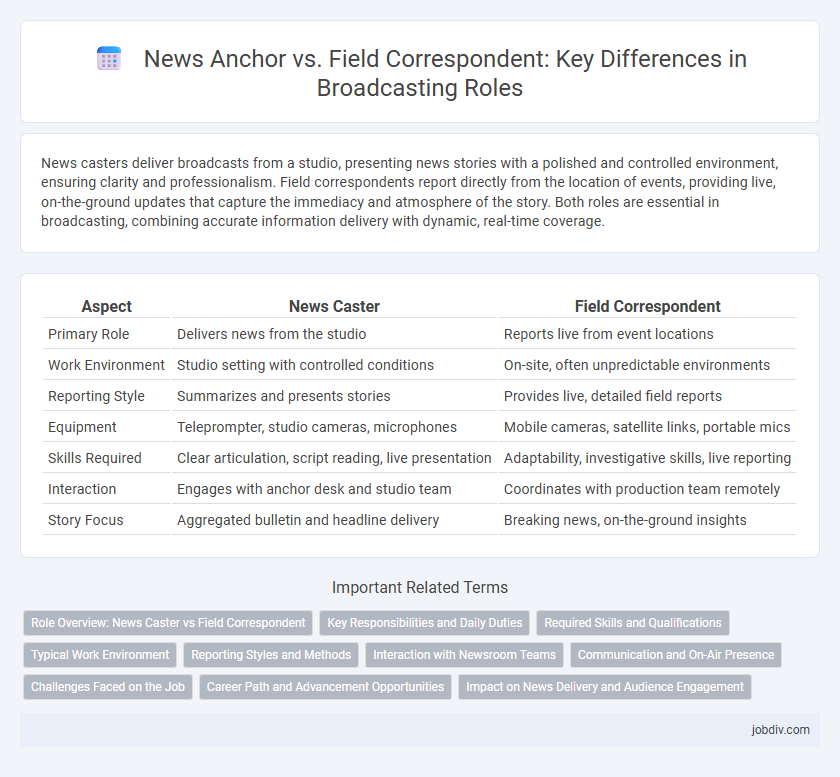News casters deliver broadcasts from a studio, presenting news stories with a polished and controlled environment, ensuring clarity and professionalism. Field correspondents report directly from the location of events, providing live, on-the-ground updates that capture the immediacy and atmosphere of the story. Both roles are essential in broadcasting, combining accurate information delivery with dynamic, real-time coverage.
Table of Comparison
| Aspect | News Caster | Field Correspondent |
|---|---|---|
| Primary Role | Delivers news from the studio | Reports live from event locations |
| Work Environment | Studio setting with controlled conditions | On-site, often unpredictable environments |
| Reporting Style | Summarizes and presents stories | Provides live, detailed field reports |
| Equipment | Teleprompter, studio cameras, microphones | Mobile cameras, satellite links, portable mics |
| Skills Required | Clear articulation, script reading, live presentation | Adaptability, investigative skills, live reporting |
| Interaction | Engages with anchor desk and studio team | Coordinates with production team remotely |
| Story Focus | Aggregated bulletin and headline delivery | Breaking news, on-the-ground insights |
Role Overview: News Caster vs Field Correspondent
A news caster anchors live broadcasts, delivering news stories from the studio with clear articulation and adherence to editorial guidelines. Field correspondents gather firsthand information on-site, reporting directly from locations of events to provide timely, in-depth coverage and eyewitness accounts. Both roles are essential in broadcasting, with news casters ensuring coherent presentation and field correspondents supplying real-time, context-rich content.
Key Responsibilities and Daily Duties
News casters primarily deliver news stories from the studio, presenting information clearly and engagingly while ensuring accuracy and adherence to broadcast schedules. Field correspondents gather on-site information, conduct interviews, and report live from locations relevant to breaking news and events. Both roles demand strong communication skills, but news casters focus on storytelling and presentation, whereas field correspondents emphasize investigative reporting and real-time updates.
Required Skills and Qualifications
News casters require strong communication skills, a clear and engaging on-screen presence, and proficiency in script reading and teleprompter use to deliver the news accurately and confidently. Field correspondents need investigative skills, adaptability to dynamic environments, and expertise in live reporting, often requiring knowledge of videography and quick decision-making under pressure. Both roles typically demand a degree in journalism or communications and experience with digital media tools to effectively engage audiences and maintain credibility.
Typical Work Environment
News casters typically work in controlled studio environments equipped with professional cameras, teleprompters, and lighting systems, ensuring a polished and consistent broadcast. Field correspondents operate in dynamic, often unpredictable settings such as on-location sites, breaking news scenes, or remote areas, requiring portable equipment and adaptability to varying conditions. Both roles demand real-time communication skills, but the studio's stability contrasts with the field's variable and sometimes challenging work environments.
Reporting Styles and Methods
News casters deliver information in a controlled studio setting, relying on teleprompters and scripted content to present concise, polished reports. Field correspondents gather firsthand accounts directly from event locations, using live feeds, interviews, and real-time observations to provide dynamic and immersive stories. The contrast between the two highlights the studio's emphasis on clarity and structure versus the field's focus on immediacy and contextual depth.
Interaction with Newsroom Teams
News casters maintain continuous communication with newsroom teams to coordinate live broadcasts and ensure scripted content aligns with the show's flow. Field correspondents relay real-time updates and situational changes from remote locations, relying on timely feedback and instructions from producers to adjust their reports. Effective interaction between news casters, field correspondents, and newsroom teams enhances the accuracy and immediacy of comprehensive news coverage.
Communication and On-Air Presence
News casters excel in delivering information with clear articulation and controlled tone from a studio environment, ensuring polished on-air presence crucial for viewer trust. Field correspondents demonstrate dynamic communication skills, adapting to unpredictable settings while providing live, on-the-ground reporting that enhances audience engagement. Effective collaboration between news casters and field correspondents balances authoritative narration with real-time storytelling, optimizing broadcast impact.
Challenges Faced on the Job
News casters contend with the pressure of delivering live information accurately under tight studio deadlines while maintaining on-screen composure and clear communication. Field correspondents face unpredictable environments, technical difficulties, and safety hazards as they gather real-time reports from diverse locations. Both roles demand resilience, quick decision-making, and adaptability to ensure timely, reliable news coverage.
Career Path and Advancement Opportunities
News casters typically start their careers in smaller local stations, gradually advancing to national broadcasts by honing on-camera presentation and script reading skills, while field correspondents often begin as reporters covering specific beats before gaining expertise in live reporting and investigative journalism. Advancement for news casters relies heavily on building a recognizable on-screen presence and credibility with viewers, whereas field correspondents progress by developing subject matter expertise and securing high-profile assignments or exclusive stories. Career paths intersect as successful field correspondents may transition to studio roles, and news casters may return to fieldwork for special assignments, both leveraging their communication skills and journalistic credibility.
Impact on News Delivery and Audience Engagement
News casters deliver information with clarity and authority from the studio, ensuring consistent and reliable news presentation that builds audience trust. Field correspondents capture real-time events on location, providing vivid, firsthand accounts that enhance audience emotional engagement and deepen story authenticity. Combining both roles creates a dynamic news delivery that balances factual reporting with immersive storytelling, significantly boosting viewer connection and retention.
News Caster vs Field Correspondent Infographic

 jobdiv.com
jobdiv.com